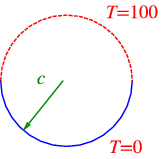8.1: Ejemplo
- Page ID
- 113805
Considera una placa circular de radio\(c \text{ m}\), aislada desde arriba y abajo. La temperatura en la circunferencia está\(100^\circ~\text{C}\) en la mitad del círculo, y\(0^\circ~\text{C}\) en la otra mitad.

La ecuación diferencial a resolver es\[\rho^2 \frac{\partial^2 u}{\partial \rho^2} + \rho \frac{\partial u}{\partial \rho} + \frac{\partial^2 u}{\partial \phi^2}{u} = 0, \nonumber \] con condiciones de límite\[u(c,\phi) = \begin{cases} 100 & \text{if $0 < \phi < \pi$} \\ 0 & \text{if $\pi < \phi < 2\pi $} \end{cases}\quad . \nonumber \]
8.1.1: Periódica BC
No hay límite real en la\(\phi\) dirección, pero introducimos uno, ya que elegimos dejar\(\phi\) correr de\(0\) a\(2\pi\) solo. Entonces, ¿qué tipo de condiciones de límite aplicamos? Nos gustaría ver “comportamiento sin fisuras”, que especifica la periodicidad de la solución en\(\phi\),\[\begin{aligned} u(\rho,\phi+2\pi)&=u(\rho,\phi),\\ \frac{\partial u}{\partial \phi}(\rho,\phi+2\pi)&=\frac{\partial u}{\partial \phi}(\rho,\phi).\end{aligned} \nonumber \] Si elegimos poner el parecer en\(\phi=-\pi\) tenemos las condiciones de contorno periódicas\[\begin{aligned} u(\rho,2\pi)&=u(\rho,0),\\ \frac{\partial u}{\partial \phi}(\rho,2\pi)&=\frac{\partial u}{\partial \phi}(\rho,0).\end{aligned} \nonumber \]
Separamos las variables, y tomamos, como de costumbre\[u(\rho,\phi) = R(\rho) \Phi(\phi). \nonumber \] Esto da las ecuaciones diferenciales habituales\[\begin{aligned} \Phi''-\lambda\Phi &=0,\\ \rho^2 R'' + \rho R' + \lambda R &= 0.\end{aligned} \nonumber \] Nuestras condiciones de límite periódicas dan una condición sobre\(\Phi\),\[\Phi(0)=\Phi(2\pi),\;\;\Phi'(0)=\Phi'(2\pi). \label{eq:phiBC} \] La otra condición límite involucra tanto\(R\) y\(\Phi\).


